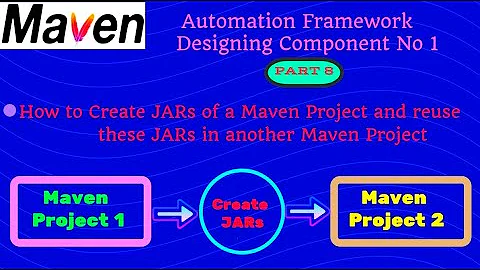Maven: best way of linking custom external JAR to my project?
Solution 1
I think you should use mvn install:install-file to populate your local repository with the library jars then you should change the scope from system to compile.
If you are starting with maven I suggest to use maven directly not IDE plugins as it adds an extra layer of complexity.
As for the error, do you put the required jars on your classpath? If you are using types from the library, you need to have access to it in the runtime as well. This has nothing to do with maven itself.
I don't understand why you want to put the library to source control - it is for sources code not binary jars.
Solution 2
You can create an In Project Repository, so you don't have to run mvn install:install-file every time you work on a new computer
<repository>
<id>in-project</id>
<name>In Project Repo</name>
<url>file://${project.basedir}/libs</url>
</repository>
<dependency>
<groupId>dropbox</groupId>
<artifactId>dropbox-sdk</artifactId>
<version>1.3.1</version>
</dependency>
/groupId/artifactId/version/artifactId-verion.jar
detail read this blog post
https://web.archive.org/web/20121026021311/charlie.cu.cc/2012/06/how-add-external-libraries-maven
Solution 3
This can be easily achieved by using the <scope> element nested inside <dependency> element.
For example:
<dependencies>
<dependency>
<groupId>ldapjdk</groupId>
<artifactId>ldapjdk</artifactId>
<scope>system</scope>
<version>1.0</version>
<systemPath>${basedir}\src\lib\ldapjdk.jar</systemPath>
</dependency>
</dependencies>
Reference: http://www.tutorialspoint.com/maven/maven_external_dependencies.htm
Solution 4
The Maven manual says to do this:
mvn install:install-file -Dfile=non-maven-proj.jar -DgroupId=some.group -DartifactId=non-maven-proj -Dversion=1 -Dpackaging=jar
Solution 5
update We have since just installed our own Nexus server, much easier and cleaner.
At our company we had some jars that we some jars that were common but were not hosted in any maven repositories, nor did we want to have them in local storage.
We created a very simple mvn (public) repo on Github (but you can host it on any server or locally):
note that this is only ideal for managing a few rarely chaning jar files
Create repo on GitHub:
https://github.com/<user_name>/mvn-repo/-
Add Repository in pom.xml
(Make note that the full path raw file will be a bit different than the repo name)<repository> <id>project-common</id> <name>Project Common</name> <url>https://github.com/<user_name>/mvn-repo/raw/master/</url> </repository> Add dependency to host (Github or private server)
a. All you need to know is that files are stored in the pattern mentioned by @glitch
/groupId/artifactId/version/artifactId-version.jar
b. On your host create the folders to match this pattern.
i.e if you have a jar file namedservice-sdk-0.0.1.jar, create the folderservice-sdk/service-sdk/0.0.1/and place the jar fileservice-sdk-0.0.1.jarinto it.
c. Test it by trying to download the jar from a browser (in our case:https://github.com/<user_name>/mvn-repo/raw/master/service-sdk/service-sdk/0.0.1/service-sdk-0.0.1.jar-
Add dependency to your pom.xml file:
<dependency> <groupId>service-sdk</groupId> <artifactId>service-sdk</artifactId> <version>0.0.1</version> </dependency> Enjoy
Related videos on Youtube
Alexandr Kurilin
Updated on May 04, 2022Comments
-
Alexandr Kurilin about 2 years
It's my first couple of days learning Maven and I'm still struggling with the basics. I have an external .jar file (not available in the public repos) that I need to reference in my project and I'm trying to figure out what my best option is.
It's a small scale project without a central repository for libraries, so it has to be either a local repository (somehow added to source control, don't know if it's supposed to work that way?) or the .jar needs to be stored on disk outside of any formal repository.
1) What's my best option for adding the .jar file to my project's references with maven given that I want both the project and the library to be in source control?
2) I still can't seem to have Eclipse see the dependency. I manually added it to the section of the pom, and it shows up fine in the Dependencies list in m2eclipse. mvn compile and mvn package both succeed, but running the program results in:
Exception in thread "main" java.lang.Error: Unresolved compilation problems: LibraryStuff cannot be resolved to a typeThis is after editing the POM as:
<dependency> <groupId>stuff</groupId> <artifactId>library</artifactId> <version>1.0</version> <systemPath>${lib.location}/MyLibrary.jar</systemPath> <scope>system</scope> </dependency>Should I be executing mvn install:install-file even thought I already have the pom.xml edited as above?
Thanks!
-
Doug T. over 11 yearsfor more on
mvn install::install-file: mkyong.com/maven/… -
 Jignesh Gohel about 10 yearsUsing the above solution shown a warning while doing "mvn clean package" - The POM for project <dependency_name> is missing, no dependency information available.
Jignesh Gohel about 10 yearsUsing the above solution shown a warning while doing "mvn clean package" - The POM for project <dependency_name> is missing, no dependency information available. -
Antonio Sesto over 9 yearsThat's the best solution for those cases where you need to add one or just few jar files. Thanks.
-
Charlie Wu over 9 yearsthis command install the lib into your maven repo. The downside of this is if you try to work on a project in a different computer, you have to run this again.
-
mauryat over 9 yearsOr, you can add local dependencies directly as in stackoverflow.com/a/22300875/640378
-
 3xCh1_23 over 7 yearsThanks, it saved a day!
3xCh1_23 over 7 yearsThanks, it saved a day! -
 Loc Phan over 7 yearsI had to use file:///${project.basedir}/libs (3 forwarded slashes) instead of file://${project.basedir}/libs
Loc Phan over 7 yearsI had to use file:///${project.basedir}/libs (3 forwarded slashes) instead of file://${project.basedir}/libs -
Maxime T about 7 yearsI've been lookin for this for years now. Thank you.
-
 Isen Ng about 7 yearsUsing
Isen Ng about 7 yearsUsingmvn install::install-fileon your local repository would mean that anyone who clones your source code would have to do this manual step as well. Otherwise, the build is broken out-of-the box -
 Isen Ng about 7 yearsIf the jar being installed, isn't an maven compiled jar, you will also need to add a new pom file to define the metadata. To save yourself all of these manual trouble, I would recommend to use
Isen Ng about 7 yearsIf the jar being installed, isn't an maven compiled jar, you will also need to add a new pom file to define the metadata. To save yourself all of these manual trouble, I would recommend to usemvn install:install-fileand then copy the entire directory structure from your local repository to your in-project repository. -
Charlie Wu about 7 yearsnice, that's most scalable solution I've found, thanks
-
dnang over 6 yearsBeware that when you create folder structure
/groupId/artifactId/version/artifactId-verion.jar, don't make the mistake of using pakage name asgroupId; instead it should be divided in a folder tree. E.g. for the groupIdorg.jsonthe path should look likeorg/json/2.0/json-2.0.jar, and notorg.json/2.0/json-2.0.jar -
cruxi over 6 yearsIf I do, do other users who pull my project have to do the same in Eclipse?
-
osk over 6 yearsHow do u know the versions of the jars and of the maven install plugin?
-
craftsmannadeem over 6 yearsversions of the jars are just made up, maven install plugin versions is the latest
-
 Cardin over 5 yearsThis method works very well when you only have the Eclipse Embedded Maven, and you lack the install plugin (offline system), so you can't run
Cardin over 5 yearsThis method works very well when you only have the Eclipse Embedded Maven, and you lack the install plugin (offline system), so you can't runinstallgoal on the depend-ed project. Ofc having an airgapped system and having all plugins but the install plugin, is quite a rare situation. -
 Ajay Kumar over 5 yearsCleanest and easiest.
Ajay Kumar over 5 yearsCleanest and easiest. -
Prachi almost 5 yearsthat won't add the jar to the war file though.
-
Dalc almost 5 yearsI was looking for a solution like this one, simply because when a new developer arrives, this simplify the installation procedure. When you don't have an artifactory server, its way easier to have the custom dependency in your project. Also when you use a CI, this solution avoid to manually install the jar on the CI server.
-
Oliver over 4 years2019 Original URL doesnt work, use this: web.archive.org/web/20121026021311/charlie.cu.cc/2012/06/…
-
 Naveen Kumar over 4 yearshow to add local dependency path which is outside ${project.basedir} folder, like I want ${basedir}\src\lib\ldapjdk.jar path 1 level up in other folder
Naveen Kumar over 4 yearshow to add local dependency path which is outside ${project.basedir} folder, like I want ${basedir}\src\lib\ldapjdk.jar path 1 level up in other folder -
 mithun_ghose about 4 yearsHow about multiple jars??
mithun_ghose about 4 yearsHow about multiple jars?? -
 garg10may about 4 yearsI am getting error -
garg10may about 4 yearsI am getting error -"The POM for … is missing, no dependency information available” even though it exists in Maven Repository -
Jonas_Hess almost 4 yearsNote that instead of constructing the libs directory structure manually, you can also do this: mvn install:install-file -Dfile=dropbox-sdk-1.3.1.jar -DgroupId=dropbox -DartifactId=dropbox-sdk -Dversion=1.3.1 -Dpackaging=jar -DlocalRepositoryPath=lib -DcreateChecksum=true This will create the structure for you and also create the checksum metadata to avoid the Maven warning.
-
 Danyal Sandeelo over 2 years
Danyal Sandeelo over 2 years<configuration> <includeSystemScope>true</includeSystemScope> </configuration>this is the main thing i believe -
 fleed over 2 yearsThis worked for me, had a jar library that is not available in a repository but only locally within a lib folder. This setup resolved the issue I was having and new machines/developers avoid the install:install issue.
fleed over 2 yearsThis worked for me, had a jar library that is not available in a repository but only locally within a lib folder. This setup resolved the issue I was having and new machines/developers avoid the install:install issue. -
 ka3ak over 2 yearsI get could not resolve depedencies... for the corresponding jars It looks like the timing is wrong Does it really install the jars before it tries to resolve the dependencies? However I ran 'mvn clean package'
ka3ak over 2 yearsI get could not resolve depedencies... for the corresponding jars It looks like the timing is wrong Does it really install the jars before it tries to resolve the dependencies? However I ran 'mvn clean package'






